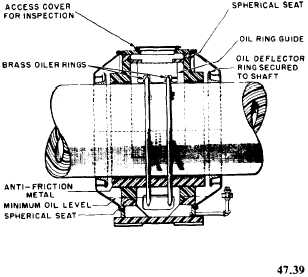ENGINEMAN 1 & C
Keep a record of the end play measurements
and refer to them when checking the main thrust
bearing. The normal wear of a pivoted shoe-type
thrust bearing is negligible even with years of use.
However, when a thrust bearing is new, there may
be slight settling of the leveling plates. If you
notice any increase in the end play, examine the
thrust shoe surfaces, and make all necessary
repairs.
In most cases, the main thrust bearing cap
must be removed for inspection. The opening is
of such size that it will permit the withdrawal of
the pair of ahead and astern thrust shoes located
in line with it.
C H E C K I N G E N D P L A Y W H I L E
RUNNING THE SHAFT.—The simplest method
of checking end play is to use a suitable measur-
ing instrument on any accessible part of the
propeller shaft while running the shaft slowly
ahead and astern. This is normally done at the
end of a run when the ship is maneuvering to ap-
proach the pier before the machinery and shaft
are cold. Although the speeds should be slow to
avoid adding deflections of bearing parts and
housing to the actual end play, these speeds should
be sufficient to overcome the rake of the shaft
and to ensure that the full end play is actually
taken up.
End play is measured with a dial indicator
mounted on a rigid support close to any con-
venient coupling flange. Occasionally a shaft may
have a shoulder turned on it for the sole purpose
of applying a dial indicator. Make sure that the
flange surface is free from paint, burrs, and rust
spots. The flange surface should also be well
oiled in order to prevent damage to the dial
indicator.
JACKING ON THE SHAFT FLANGE.—If
it is not feasible to measure the end play of a shaft
while running, your next choice is to jack the shaft
fore and aft at some convenient main shaft flange.
Use a dial indicator make certain that the shaft
movement is free, and guard against overdoing
the jacking force. The main difficulty associated
with the use of the jacking methods is in finding
suitable supports to ensure that no structural
damage will be incurred when jacking is done
against a main shaft flange coupling.
MAIN PROPULSION SHAFT
BEARINGS
You will be required to watch and maintain
the main propeller shaft bearings. These bearings
support and hold the propulsion shafting in align-
ment. They are divided into two general groups:
the main line shaft bearings (spring bearings), and
the stern tube and strut bearings.
MAIN LINE SHAFT BEARINGS
(SPRING BEARINGS)
The main line shaft bearings (spring bearings)
are of the ring-oiled, babbitt-faced, spherical seat,
shell type. These bearings (figure 4-3) are designed
primarily to align themselves to support the weight
of the shafting. In many of the older, low-
powered ships, the bearings are not of the self-
aligning type and consist only of bottom halves.
The upper half of each assembly consists only of
a cap or cover (not in contact with the shaft)
designed to protect the shaft journal from dirt.
The spring bearings of all modern naval ships,
however, are provided with both upper and lower
self-aligning bearing halves.
The brass oiler rings (figure 4-3) hang loosely
over the shaft journal and the lower bearing half,
and are slowly drag fed around by the rotation
of the shaft. The upper half of the bearing is
Figure 4-3.—Main line shaft bearing.
4-8


